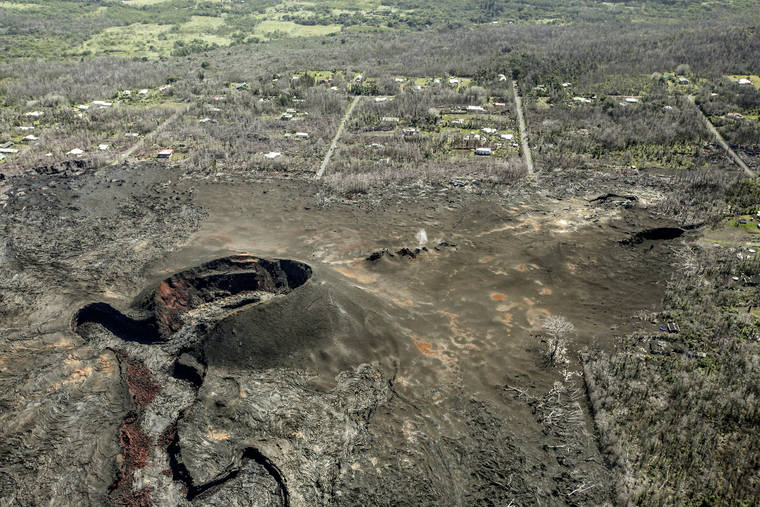The question of what to call the most prominent remaining feature from the 2018 Kilauea volcano eruption will not be answered for several more months.
At the start of this year, the state Board of Geographic Names began soliciting name suggestions for fissure 8, the most productive of the dozens of volcanic vents that opened during the eruption. A permitted interaction group formed by the board has met with Puna community members on multiple occasions to discuss their naming preferences.
Almost one year — and 21 names — later, the interaction group submitted its final report to the Board of Geographic Names, which will discuss the report during its next meeting in early January.
However, the board is unlikely to choose a name during that meeting. Marques Marzan, chairman of the board, said the panel will begin the discussion in January, but will not make a decision until a subsequent meeting.
“We wouldn’t want to just make a decision on behalf of the community without bringing it before the Puna community,” Marzan said.
When the board finally selects a preferred name — possibly after several board meetings — Marzan said the panel will schedule one more community meeting in Puna to solicit feedback.
“It really is the community’s decision to make,” Marzan said.
The permitted interaction group determined four of the 21 submitted names were worthy of greater consideration than others because they were submitted by people with high cultural ties to the area.
Those names include: “Pohaka‘ena,” which means “exploding rage”; “Ke Ahi Ena‘ena,” meaning “raging fire”; “Ahu‘aila‘au,” which refers to an altar to the volcano deity ‘Aila‘au; and “Keahiluawalu O Pele,” which originated in a dream, the submitter claimed.
Some members of the public testified during a November meeting of the County Council’s Governmental Relations and Economic Development Committee in support of the latter two names.
Marzan said those names are not the only possible choices for the landmark, and the remaining 17 names will still be considered by the board.
Those remaining names are:
• Puu Leilani (named for the subdivision, Leilani Estates, where the fissure is located).
• Pu‘uo‘aila‘au (Hill of ‘Aila‘au).
• Pu‘u Kupaianaha (Pu‘u = hill; Kupaianaha = surprising, strange, wonderful, marvelous).
• Pu‘u ‘O Luku (hill of destruction).
• Hanaia‘na (creation).
• Enoho (regeneration).
• Hou Ho‘omaka (new beginnings).
• Keahilapalapa (spreading or blazing fire).
• Kekoheho‘ohenonohoikala‘iopunapaia‘alaikahala (cherished crease occupying the calm of Puna of the forest bower fragrant with pandanus).
• Luana-Lani (named after Luana Street in Leilani Estates).
• Papalauahi (earth of numerous volcanic eruptions; proposed name for all 24 fissures).
• Pohaha (a reduplicative of paha, which can mean breaking forth, bursting, cracking and volcanic ejecta of any kind).
• Hopena (fate or destiny).
• Pu‘ O‘oo‘o or Pu‘u O‘o O‘o (references to fellow cinder cone Pu‘u ‘O‘o, which was formed in 1983 and named after its proximity to a letter “O” on a map).
• Pu‘u Wa Kahiko (an eternity from past to present).
• ‘Omakaolahoukaluaokalani (source of the rebirth of the second heaven).
Email Michael Brestovansky at mbrestovansky@hawaiitribune-herald.com.






